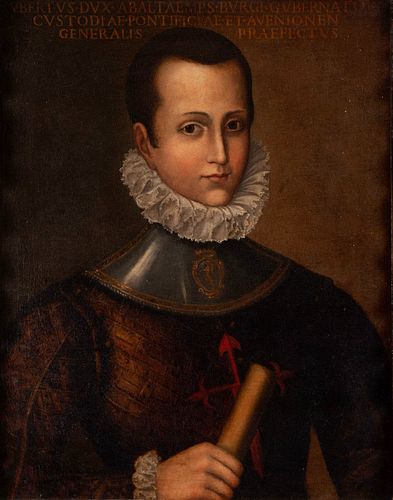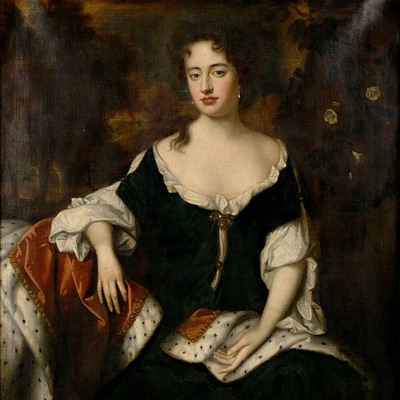AN IMPORTANT PORTRAIT OF ROBERTO D'ALTEMPS, 1ST DUKE OF GALLESE (ITALIAN SCHOOL, LATE 16TH CENTURY)
About Seller
555 Washington Ave, Ste 129
St. Louis, MO 63101
United States
Two ways to bid:
- Leave a max absentee bid and the platform will bid on your behalf up to your maximum bid during the live auction.
- Bid live during the auction and your bids will be submitted real-time to the auctioneer.
Bid Increments
| Price | Bid Increment |
|---|---|
| $0 | $5 |
| $30 | $10 |
| $100 | $25 |
| $500 | $50 |
| $1,000 | $100 |
| $3,000 | $250 |
| $5,000 | $500 |
| $10,000 | $1,000 |
| $30,000 | $2,500 |
| $50,000 | $5,000 |
| $100,000 | $10,000 |
| $300,000 | $25,000 |
| $500,000 | $50,000 |
About Auction
Jan 14, 2023
Featuring a collection from the estate of St. Louis philanthropists and socialites Lee Renfrew Wallace and Mahlon Brookings Wallace III: 154 lots highlighted by bronzes and oil works from artists of the American West, along with silver, decorative arts, furniture, & important 17th c. portraiture. Selkirk Auctioneers & Appraisers info@selkirkauctions.com
- Lot Description
AN IMPORTANT PORTRAIT OF ROBERTO D'ALTEMPS, 1ST DUKE OF GALLESE (ITALIAN SCHOOL, LATE 16TH CENTURY)
Oil on canvas, unsigned. The subject in lace ruff above silver collar with the crowned heraldic crest of a ram with shield above an armored vest with red cross; holding a scroll in his right hand.
The Latin phrase "RVBERTVS DVX ABALTAEMPS BVRGI GVBERNATOR CVSTODIAE PONTIFICIAE ET AVENIONEN GENERALIS PRAEFECTUS" painted above the whole.
The sitter, Roberto d'Altemps, was the illegitimate son of Marco Sittico Altemps and of the woman he loved, the Genoese Camilla Bonfiglio, to whom Marco Sittico privately sent (as stated in the ledger of 1577) a monthly pension. His father, who was embarking on an ecclesiastical career, subsequently recognized and legitimized his son, but nevertheless decided to continue his ecclesiastical career which led him to the rank of cardinal, also sponsored by his cousin Carlo Borromeo .
He grew up under the protection of his father and above all of Gregory XIII with whom the Altemps family had excellent relations, and like other young nobles of his time he had a decisive and strong-willed character, but at the same time his father tried to root his family in the Roman nobility through a prestigious marriage and for this reason Roberto was married to Cornelia Orsini (December 1576), daughter of Virginio, 1st Duke of San Gemini, exponent of the ancient and powerful Orsini dynasty of Rome. In the same year of his marriage, Roberto would be created Duke of Gallese by Pope Gregory XIII. In 1579, Roberto was also appointed prefect of the papal armies in Avignon and his father had provided him with the fiefdoms of Soriano, Rocchette, Tassignano and Mesuraca from the Madruzzos.
In 1585 with the death of Gregory XIII, a new pope, Sixtus V, ascended the throne of Peter, who immediately tried to put a stop to the power of the noble Roman families over the papal curia and to moralize customs. The new pontiff was well aware of the delicate situation involving Roberto's father, as well as the character of the young man, whose hasty ways he certainly did not appreciate. Furthermore, the Altemps had been one of his opponents during the last conclave that had led to his accession to pontiff and had opposed him with a group of traditionalists who wanted to maintain the status quo of the curia.
With an ad hoc trial, Roberto was accused of adultery at the age of twenty and sentenced to death by decapitation at the behest of Sixtus V in 1586. The pleas of his cardinal father were useless to which the pontiff replied contemptuously: "there can be no clemency for those who break the laws, even if they are young, noble or prelate". Before Roberto's execution, he also wrote to the pontiff Cornelia, the young man's wife, who was carrying the couple's child, but always without success.
Marco never recovered from the death of his son and, although not knowing that he could not be personally accused of crimes, he temporarily decided to leave his posts, while Sixtus V still raged against him and his family by publishing the apostolic constitution Postquam verus of 1586, Sixtus V had established that anyone who had offspring could not become a cardinal, which would have led Marcus to be excluded from the college of cardinals.
He retired to Palazzo Altemps in Rome where he dedicated himself to modernizing the building, having the large loggia of the structure and the interior frescoed with a series of metaphors, allegories and typical symbols of esotericism, to recall the unfair trial suffered by his son. Pope Clement VIII , who still as a cardinal had discreetly supported the Altemps and who, in private, had always criticized the death of his cardinal friend's son, decided to "repay" the offense suffered by his family by donating in 1602 to the son of Roberto, Giovanni Angelo, the body of Pope Sant'Aniceto, martyred by decapitation.
Stretcher: 26 x 20 3/4 in. (66 x 52.7 cm.), frame: 30 3/4 x 25 1/4 in. (78.1 x 64.1 cm.) - Shipping Info
-
The buyer is responsible for arranging pick-up and shipment of all purchased lots. All registered bidders are responsible for obtaining quotes through in-house shipping or a third-party shipping agent, in advance of bidding. A list of third-party shippers is made available on Selkirk’s website, as well as at the time of invoicing. Not all items are eligible for in-house shipping. Selkirk will not be responsible for any loss, damage, theft, or otherwise responsible for any items left in Selkirk’s possession ten (10) days after the sale. If arrangements for shipping have not been made and communicated within thirty (30) days, Selkirk reserves the right, at this time, to charge a storage fee of $10 per lot per day for furniture and large format items and $5 per lot per day for all other items, and within sixty (60) days, at its own discretion, sell any items left on the premises. Accumulated fees resulting from storage and insurance cost will be taken out of any proceeds. Objects that contain materials of endangered or protected species may be subject to regulations disallowing export and import into other states or countries. It is the buyer’s responsibility to be aware of all applicable laws and regulations and to obtain any required export or import licenses or certificates and any other required documentation.
-
- Buyer's Premium



 EUR
EUR CAD
CAD AUD
AUD GBP
GBP MXN
MXN HKD
HKD CNY
CNY MYR
MYR SEK
SEK SGD
SGD CHF
CHF THB
THB

















